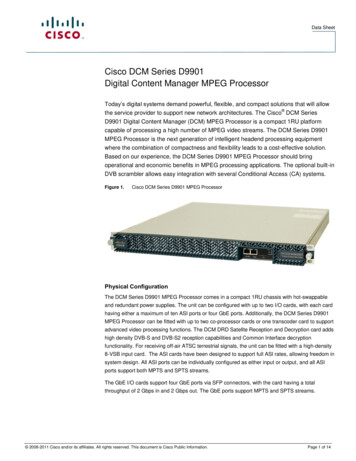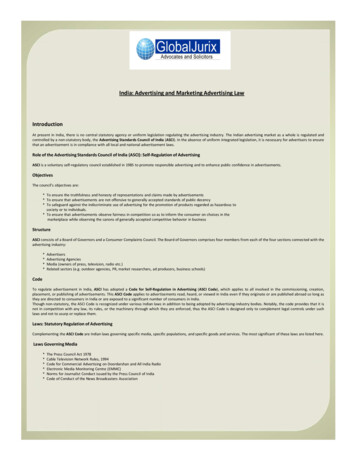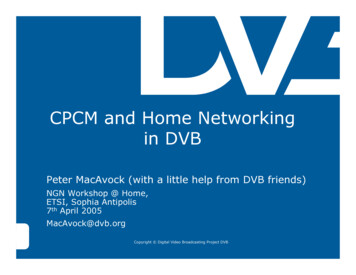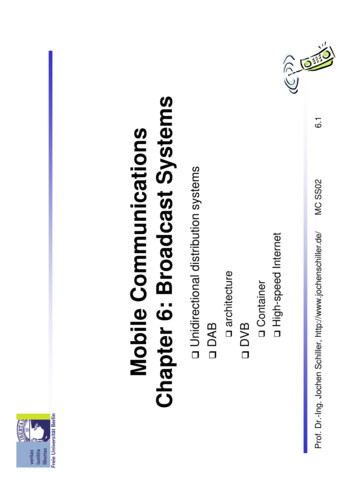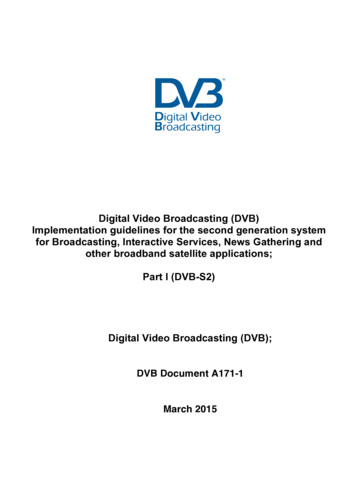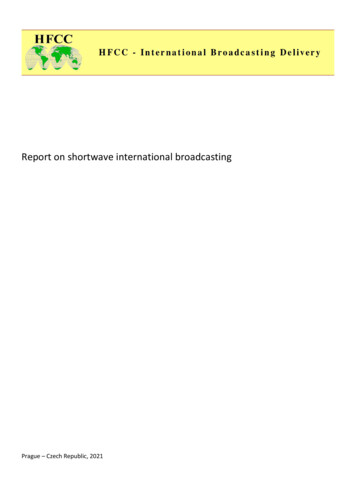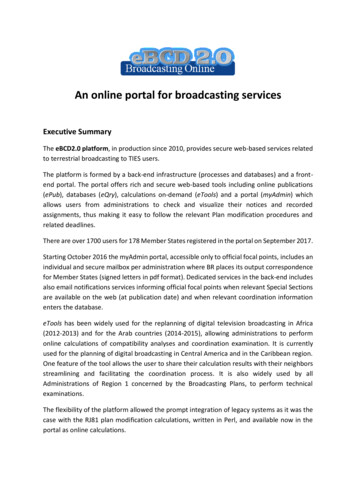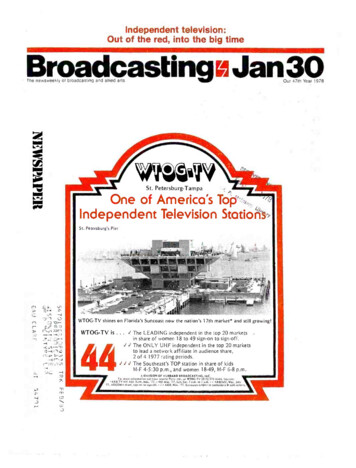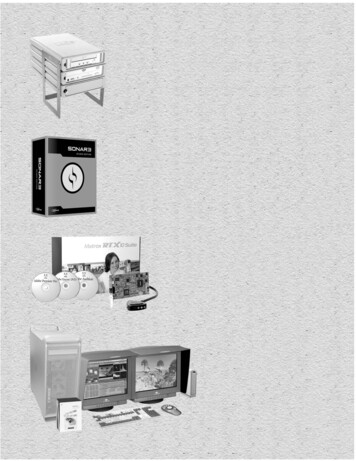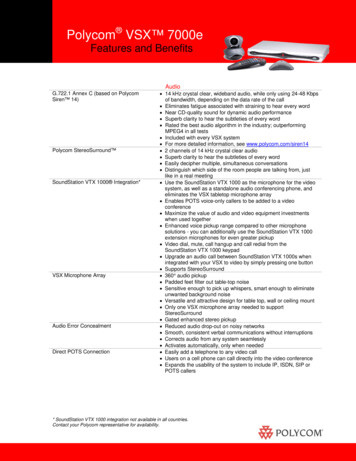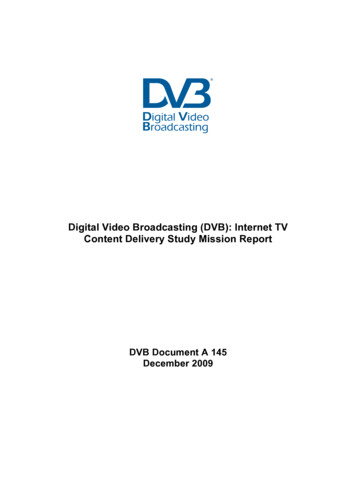
Transcription
!!!!!!!!!!!!!!!Digital Video Broadcasting (DVB): Internet TVContent Delivery Study Mission ReportDVB Document A 145December 2009
2DVB Study Mission Report V 1.0.2 (2009-11)Reference void KeywordsDVB, Internet TV Services, Internet TV ContentDeliveryDVB
3DVB Study Mission Report V 1.0.2 (2009-11)ContentsForeword. 5Contributors . 5Introduction . 61 Scope . 72 References . 83 Definitions, symbols and abbreviations . 93.1 Definitions . 93.2 Abbreviations . 94 Executive Summary . 124.1 Summary of the Study Mission Process . 124.2 How to read this Study Mission Report . 124.3 Major Conclusions . 145 Overview Internet TV Content Delivery . 165.1 Definitions . 165.1.1 Internet TV Content Delivery . 165.1.2 Considered Content Types . 165.2 Considered Actors in the Value Chain . 165.3 Technologies and Services in Scope of this Study Mission . 175.3.1 Technologies . 175.3.2 Example Services . 175.4 High-Level Evaluation Criteria . 186 Information Gathering Process and High Level Review. 196.1 Information Gathering Process . 196.2 Technologies Contributing to Questionnaire . 196.2.1 Summary . 196.2.2 Open IPTV Forum . 206.2.3 Anysee . 206.2.4 BitTorrent. 216.2.5 GridCast . 216.2.6 MHEG-5 with Interaction Channel . 216.2.7 P2PSIP-based distributed IPTV . 216.2.8 PayTV DVB-Tuner . 226.2.9 Samsung P2P-TV . 226.2.10 StreamForge . 226.2.11 NPO Hybrid Distribution . 226.2.12 emundoo . 226.2.13 CoolStreaming . 236.2.14 Predictable Reliability under Predictable Delay for IP media services . 236.2.15 NextShare . 236.2.16 ZDF Mediathek . 236.2.17 GEM-IPTV . 246.2.18 Scalable Video Coding. 246.2.19 Apple http live streaming . 246.2.20 DVB-IPTV Content Download Service (CDS). 246.2.21 IIS Smooth Streaming . 256.2.22 Philips Net TV . 266.3 Other Submitted Internet TV Content Delivery Technologies . 266.3.1 Summary . 266.3.2 Octoshape. 266.3.3 Abacast. 276.4 Other Internet TV Content Delivery Technologies . 276.4.1 Summary . 276.4.2 Zillion TV . 27DVB
4DVB Study Mission Report V 1.0.2 (2009-11)6.4.3 Move Networks . 276.4.4 Velocix . 286.4.5 PPlive . 286.4.6 TVU Networks . 286.4.7 IETF P2P Streaming Protocol (PPSP) . 286.5 Other Known Internet TV Content Delivery Technologies . 297 Categorization of Technologies . 307.1 Introduction . 307.2 Definitions . 307.3 Categorization . 308 Summary of Different Aspects in Questionnaire and Internet TV Content Delivery . 348.1 Introduction . 348.2 Commercial Aspects . 348.3 Standardization and Specification Aspects . 368.4 Technical Aspects . 378.4.1 Architectures . 378.4.2 End-device Functions and Platforms . 438.4.3 Content and Network Security . 458.4.4 Communication Protocols . 508.4.5 Content Search and Metadata . 518.4.6 Codec and Encapsulation Formats . 538.4.7 QoS Tools . 538.4.8 Key Performance Indicators . 569 Relation to Business Models and Commercial Case Study . 609.19.29.39.49.59.6Introduction . 60Novel Aspects of Internet TV . 60Market Situation and Evolution . 60Regulatory Issues . 61Standardization . 62Summary . 6310 Architectural Examples . 6410.1 Introduction and Scope . 6410.2 Baseline Architecture . 6510.3 Scalable Content Delivery Architectures . 6810.3.1 Introduction . 6810.3.2 Broadcast and Multicast Architectures . 6810.3.3 Server-based Scalability CDNs . 6910.3.4 Peer-to-Peer-based Scalability . 7010.3.5 Hybrid CDN/P2P Delivery Architectures . 7310.4 Refined Example Architectures . 7410.4.1 Introduction. 7410.4.2 Example 1: Open IPTV Forum . 7410.4.3 Example 2: DVB-IPTV CDS . 7510.4.4 Example 3: Microsoft IIS Smooth Streaming . 7610.4.5 Example 4: BitTorrent . 7710.4.6 Example 5: Samsung P2P-TV . 7810.4.7 Example 6: NextShare . 79DVB
5DVB Study Mission Report V 1.0.2 (2009-11)ForewordThis Study Mission Report has been produced by the DVB Project. Founded in September 1993, the DVBProject is a market-led consortium of public and private sector organizations in the television industry. Itsaim is to establish the framework for the introduction of digital television services. Now comprising over 200organizations from more than 25 countries around the world, DVB fosters market-led systems, which meetthe real needs, and economic circumstances, of the consumer electronics and the broadcast industry.ContributorsThe following volunteers contributed to and assisted in the completion of this Study Mission Report:1Anton HavekesOn behalf of KPN2Damien AlliezNDS Ltd3Dave WaltonEchostar4Désirée GianettiDVB5Dmitri JarnikovIrdeto6Fabrizio RovatiSTMicroelectronics7Franc KozamernikEBU-European Broadcast Union8Guy HirsonOn behalf of Microsoft Corporation9Ingo ReeseMacrovision10Julien MaisonneuveAlcatel Lucent11Kyung Ho KimLG Electronics12Mark StuartPioneer Digital Design - Pioneer Electronics Europe13Martyn LeeBSkyB14Michael LagallySun Microsystems GmbH15Muriel DeschanelMicrosoft Corporation1617O-Hoon KwonPaul SzucsSamsung ElectronicsSony18Peter Jan DoetsOn behalf of KPN19Peter LaniganPhilips2021Peter SiebertPhilipp SteckelDVB Project OfficeInstitut für Nachrichtentechnik - TU-Braunschweig22Rainer KirchknopfZDF - Zweites Deutsches Fernsehen23Seongho ChoSamsung Electronics Co., LTD.24Simon GauntlettUK Digital Television Group25Simon WallerSamsung Electronics26Stuart SavageZetaCast (representing Microsoft)27Susana SabaterEricsson28Sven ReuterLG Electronics Inc.29Teodor BuburuzanInstitut für Nachrichtentechnik - TU-Braunschweig30Thomas StockhammerLG Electronics (Chair and Editor)In addition, technology submissions were provided by non DVB members. The editors of these submissionsare mentioned in Annex B-D of the extended Study Mission Report [4].DVB
6DVB Study Mission Report V 1.0.2 (2009-11)IntroductionIn March 2009, the Technical Module (TM) of the DVB Project decided to launch a Technology Study Mission on Internet TV Content Delivery. This Study Mission was carried out in the ad-hoc group Internet Protocol Infrastructures (TM-IPI) of the Technical Module and was chaired by Dr. Thomas Stockhammer (LGElectronics). The rationale for this Study Mission was mainly to investigate technology options to deliverDVB type content over the Internet to a large number of CE devices (includes game consoles), PCs or mobile devices. DVB provided specific guidelines on what is expected from the study mission.The Study Mission was kicked off on April 17, 2009 and was completed on September 22, 2009. The StudyMission report was presented to DVB Technical Module on September 25, 2009 and approved by the DVBSteering Board on 21 October 2009. During this period the Study Mission collected the information in thisreport within 27 regular meetings. Three of these meetings were face-to-face meetings, the remainder wereonline meetings. A significant amount of discussion also happened over an e-mail list that was specificallysetup for this Study Mission.The information collected in this Study Mission is to a large extent based on information collected during apublic questionnaire process. The questionnaire triggered 21 replies on different technologies in the area ofInternet TV content delivery. Additional information on other technologies was collected based on overviewdocuments from technology providers or Study Mission internal summaries. The provided information issummarized in different categories.This report is a short version of the DVB-internal Study Mission Report [4]. Whereas the DVB-internal version is only available to companies which are members of the DVB Project, the current version is madeavailable to organisations outside DVB.DVB
71DVB Study Mission Report V 1.0.2 (2009-11)ScopeThe DVB Technical Module defined the following scope for the Internet TV Content Delivery Study Mission. The Study Mission shouldinvestigate technology options to deliver DVB type content over the Internet to a large number of CEdevices (includes game consoles), PCs or mobile devices.focus on content delivery, other functions such as codecs, security, etc. can be considered, but neednot be the core of the report and slow down the release.attempt to include subject matter experts in the field of Internet Content Delivery to ensure a wide andcomprehensive consideration of technology options and the most accurate evaluation against thehigh level evaluation criteria.investigate suitability of Peer-to-Peer and compare it with other Internet distribution technologies suchas:o Existing DVB-IPTV technologies, with any necessary modifications (e.g. CDS)o Technologies used in existing Internet TV deploymentso Technologies specified by other standardisation and industry bodiesinvestigate suitability of Peer-to-Peer in combination with other Internet distribution technologiesconsider all players of the Internet-TV value chainconsider different types of DVB serviceso LiveTV (Streaming)o Content on Demand (Streaming or Download)It was seen critical to have existing Internet TV service providers (including the major European broadcasters) involved. The Study Mission and this Study Mission Report attempt to fulfil the scope by collectingadequate technical and non-technical information. The collected information is provided in this Study Mission Report and evaluated and assessed to the extent it was considered reasonable.DVB
82DVB Study Mission Report V 1.0.2 (2009-11)ReferencesThe following referenced documents are not essential to the use of the present document but they assist theuser with regard to a particular subject area. For non-specific references, the latest version of the referenceddocument (including any amendments) applies.[1]ETSI TS 102 034: "Digital Video Broadcasting (DVB); Transport of MPEG-2 TS BasedDVB Services over IP Based Networks".[2]ETSI TS 101 154: "Digital Video Broadcasting (DVB); Implementation guidelines forthe use of MPEG-2 Systems, Video and Audio in satellite, cable and terrestrial broadcasting applications".[3]ETSI TS 102 005: "Digital Video Broadcasting (DVB); Specification for the use of Videoand Audio Coding in DVB services delivered directly over IP protocols".[4]WP U ³'LJLWDO 9LGHR %URDGFDVWLQJ '9% ,QWHUQHW 79 &RQWHQW 'HOLYHU\ 6WXG\ 0Lssion ReSRUW 2FWREHU [5]cm-LSWY ³Commercial case for Internet TV (Public Version) 2FWREHU DVB
9DVB Study Mission Report V 1.0.2 (2009-11)3Definitions, symbols and abbreviations3.1DefinitionsFor the purposes of the present document, the following terms and definitions apply:QoE : observed quality by the Internet TV ConsumerQoS: measurable quality of the content delivery.NOTE: Additional definitions are interleaved in the remainder of the document.3.2AbbreviationsFor the purposes of the present document, the following abbreviations apply:AACAdvanced Audio CodingAESAdvanced Encryption StandardAPIApplication Programming InterfaceARIBAssociation of Radio Industries and BusinessesATSCAdvanced Television Systems CommitteeAVMSAudiovisual Media Services DirectiveBCGBroadband Content GuideCASConditional access system5CDAContent Delivery AssistanceCDNContent Delivery NetworkCDSContent Download ServiceCoDContent-on-DemandCEAConsumer Electronics AssociationCEConsumer ElectronicsCERNETChina Educational and Research NetworkCICommon InterfaceCMSContent Management SystemCPUCentral Processing UnitDiffServDifferentiated ServicesDNADelivery Network AcceleratorDRMDigital Rights ManagementDTCPDigital Transmission Content ProtectionDVBDigital Video BroadcastingDVB-AVCDVB-Audio Video CodingDVB-CDVB-CableDVB-CPCM DVB-Content Protection & Copy ManagementDVB-FFDVB-File FormatDVB-SDVB-SatelliteDVB-SIDVB-Service InformationDVB-TDVB-TerrestrialEBUEuropean Broadcast UnionETSIEuropean Telecommunications Standards InstituteEUEuropean UnionFECForward Error CorrectionFLUTEFile Delivery over Unicast TransportGEMGlobally Executable MHPGOPGroup-of-PicturesHDTVHigh-Definition TeleVisionHbbTVHybrid Broadcast Broadband TVHE-AACHigh-Efficiency AACHNEDHome Network End DeviceHTMLHyperText Markup LanguageDVB
SSMSTBSVCTCPTLSTMTM-IPITPMTSTVTVAUDPUNIURIVoDDVB Study Mission Report V 1.0.2 (2009-11)Hypertext Transfer Protocolsecure HTTPInteraction ChannelInternet Engineering Task ForceInternet Group Management ProtocolIntellectual Property RightsInternet Protocol TeleVisionInternational Standards OrganizationInternet Service access ProviderInternational Telecommunications Union Telecommunications SectorInternet TV Content ProviderInternet TV Service ProviderLive Media BroadcastMultimedia and Hypermedia information coding Expert GroupMultimedia Home PlatformMPEG-4Moving Pictures Experts GroupNetwork Address Translationnetwork Personal Video RecorderNetwork Service ProviderOpen IPTV ForumPeer-to-PeerPeer-to-Peer Session Initiation ProtocolPersonal ComputerP2P Streaming est, Shamir und Adleman (refers to algorithm for public-key cryptography)Resource Reservation ProtocolReal-Time Control ProtocolReal-Time ProtocolReal-Time Streaming ProtocolStream Control Transmission ProtocolStanDardization OrganizationService Discovery and SelectionSession Description ProtocolStandard-Definition TeleVisionSecure Hash AlgorithmSession Initiation ProtocolSecure RTPSecure Sockets LayerSource Specific MulticastSet-Top BoxScalable Video CodingTransmission Control ProtocolTransport Layer SecurityTechnical ModuleTechnical Module IP InfrastructureTrusted Platform ModuleTransport StreamTeleVisionTV AnytimeUser Datagram ProtocolUser-Network-InterfaceUniform Resource IdentifierVideo-on-DemandDVB
11WMAWMVWindows Media AudioWindows Media VideoDVBDVB Study Mission Report V 1.0.2 (2009-11)
12DVB Study Mission Report V 1.0.2 (2009-11)4Executive Summary4.1Summary of the Study Mission ProcessProviding DVB services over the Open Internet has been an ongoing discussion in commercial and technicalgroups in DVB for some time. In March 2009, DVB decided to launch a technical Study Mission on InternetTV Content Delivery to investigate technology options to deliver DVB type content over the Internet to alarge number of CE devices (includes game consoles), PCs or mobile devices. DVB provided specific guidelines on what is expected from the study mission.The study mission was kicked off on April 17, 2009 and was completed on September 22, 2009. The StudyMission Report is presented to DVB TM on September 25, 2009. During this five months period the StudyMission collected the information in this report within 27 regular meetings. Three of these meetings wereface-to-face meetings, the remaining ones were telephone conferences and web sessions. A significantamount of discussion also happened over an e-mail list that was specifically setup for this Study Mission. Atotal of 140 DVB members had subscribed to this list. The number of participants in the meetings varied between four and 35 with typically more than 10 participants. The number of attendees was lower during thesummer months July and August for obvious reasons.To collect relevant information and to attract a significant amount of experts within and also outside DVB, itwas decided to issue a public questionnaire to obtain information on existing technologies in the area ofInternet TV Content Delivery. The first month of the Study Mission was dedicated to complete this publicquestionnaire and to identify relevant technologies in this area. The questionnaire was published on May22nd, 2009, on the DVB website and it is included in the extended Study Mission Report [4] in Annex A.Members of the Study Mission task force explicitly contacted technology providers asking for the submission of technologies and providing assistance in case of questions. The questionnaire triggered 21 replies ondifferent technologies in the area of Internet TV content delivery. Additional information was collected inAnnex C and Annex D of the extended Study Mission Report [4] from technologies that did not have sufficient time to complete the questionnaire or did not respond to the request for information.During two of the face-2-face meetings, the submitters of the technology were given the opportunity to present their technology within the DVB Study Mission. All submitters of the technologies accepted this invitation and presented their technologies within the Study Mission. The presentation slides, if used, have beenmade available to DVB and can be accessed in the DVB TM-IPI documents folder.The Study Mission Task Force collected, categorized and summarized the information by middle of August2009. As some of the replies and technology su
DVB 2 DVB Study Mission Report V 1.0.2 (2009-11) Reference void Keywords DVB, Internet TV Services, Internet TV Content Delivery

